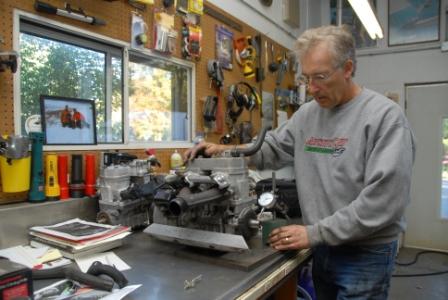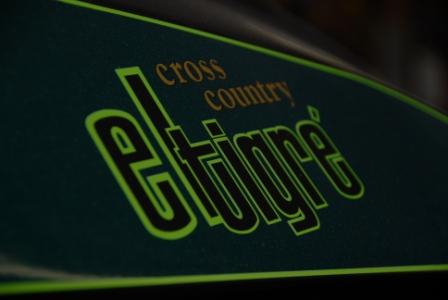The image of Team Arctic’s Brian Nelson skimming down a Northern Minnesota ditchline, chasing victory in the I-500 aboard an Arctic Cat el tigre Cross-Country Cat, has been confined to memory for the past three-plus decades.
This winter it’s going to be a reality once again.
Having been bitten by the vintage bug at last year’s Snowmobile Hall of Fame Ride with the Champs, Nelson wanted to build a Cross-Country Cat for the 2011 event. So last spring he went into accumulation mode, buying a few 1979 440s from which he’d build a beauty.
Then word came that USCC was going to have a vintage class at the 2011 I-500.
Nelson kicked himself into overdrive.
I’ve had the great fortune to know and race with Brian for the past 17 years. And I’m here to tell you: if there’s someone in this sport whose approach to racing at their very best is greater and more detailed than Nelson’s, I haven’t yet met them.
So it was on this Sunday in October, I once again found myself at Nelson’s race shop in Spicer, Minn., seeing the preparations of a snowmobile racing legend and hearing incredible stories about racing in cross-country during it’s first hayday.
There is only one other person in whole world who knows as much about the famed 1978-79 Cross-Country Cats as Nelson: his friend and mechanic from that period, Hubert Fixsen.
These two guys were hired by Arctic Cat to turn the CC Cat into a race winner. Their success in this endeavor is well documented, with Nelson winning the I-500 aboard a kitted 340cc model in 1978. The duo brought many key innovations to the machine, focusing mainly on suspension performance and handling. These two knew every bolt and rivet on these machines.
Now 57, Nelson commands a memory of these sleds that vaporizes the 32-year span. When disassembling a skidframe during the day, I grabbed a half-inch aluminum spacer from the idler wheel shaft, showed it to Brian and tested if he knew what it was. He didn’t even pause before answering.
Amazingly, one of the seven sleds Brian bought last spring was actually one of his very race sleds from the 1979 season. He first noticed some bulkhead grinding on the sled that was consistent with his sled prep from back in the day. Then he noticed four holes on the side of the bellypan that held a manufacturer’s plate, so he knew it had to be a factory sled. The kicker came when he removed the vinyl seat cover, exposing the brown-bag-wrapped foam.
Back in the day, Nelson always wrapped his seat foam with these brown bags that were in abundance at Arctic Cat, to prevent water from getting into the foam.
When he saw the bag-wrapped foam, he knew it was one of his race sleds from three decades earlier.
As a testament to his preparation in ’79, the seat foam was still perfect. The other six seat foams ranged from barely usable to nearly-destroyed.
Nelson’s approach to racing has always been one of absolute professionalism. And his rebuilding of three ’79 CC Cats will incorporate some modern elements, such as Fox Gas Shox, new tracks and more durable steering components.
Why three sleds for the coming season? Nelson wants to test different set-ups in each sled, he has enough parts and he wants to support the USCC event. So come I-500 raceday, Nelson will be joined by longtime friend Joey Hallstrom and myself on this trio of Cats.
Personally, my only goal in the race is to beat Joey. And yesterday at the shop, I performed a few “tweaks” to Joey’s sled to ensure that I’ll beat him.
The motors have come out, cranks checked and freshened up as needed. Nelson likes to have himself and his race sleds ready for snow by mid-November, so that when the white stuff falls, the riding can begin.
Two of three race sleds were completely stripped, sand-blasted and repainted. This baby looks like it just rolled off the production line.
One of the difficulties in racing 30-plus-year old sled is getting parts. Finding original tracks is next to impossible. So new tracks are used instead, but sometimes require modification to work with original suspension. Here Nelson takes a break from cutting track windows to fit the original skidframe.
Working on the linkage rear suspension that he and Fixsen designed.
If Brian’s race shop could tell stories, they would all be about long hours and attention to detail. When Brian tells stories, he recollects the details as if it happened five minutes ago. Yesterday I heard a great story about the final leg of his ’78 win, battling with Ron Reimer to the thrilling end. When I return to Nelson’s shop in a couple weeks, I’ll bring my video camera and capture his retelling for future posting.
In addition to prepping three sleds, Nelson lost 37 lbs. over the past six months to get his body into the kind of shape needed to race 170 miles in a day. He’s fit, trim and sharp as ever. I know I won’t be able to run with him, but like I said… my goal is to beat Hallstrom. Heh-heh-heh!
Nelson’s ultimate goal with this project is to spur interest in the race and do his best. He’s been in touch with several of his fellow racers from back in the day, and would love nothing more than to share some new experiences with these guys and everyone else who’s planning to line up in TRF for the start of what will be a historic I-500 cross-country.
He (and I) hope to see you there. In the meanwhile, Brian’s getting back to the task at hand…

